Rivers to the Sound Gallery
Rivers move plants, animals and nutrients to and from Long Island Sound. Narrow or wide, as small as trickles or rushing torrrents, rivers link the shore to inland forests and provide travel routes for animals moving upstream or downstream. All rivers and streams in the watershed that run through Connecticut and southeastern New York eventually flow into Long Island Sound. Rivers create natural pathways for fish, birds, humans and other mammals to travel to and from the sea. The interconnected system of streams, rivers and ground water that flows into the Sound is home to millions of people. Whatever is found upriver, on land, near a stream or in a storm drain all ends up down in the Sound.
River Otter
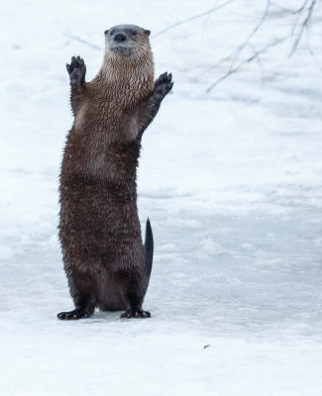
The North American River Otter (Lontra canadensis) is a member of a family of animals known as the mustelids or weasels. This group also includes fishers, badgers, skunks, stoats, minks, ferrets, polecats and martens. River otters are found across all freshwater areas of the planet and the population in Connecticut (approx. 1500) is large enough to support a restricted harvest. Trapping season in Connecticut occurs from November 3rd to mid-March with a limit of 8 otters per season, per trapper.
The otter is characterized by having short legs with webbed feet, a long and slender body with a thick, somewhat flattened rudder-like tail, dense brown fur which is generally lighter in color along the throat and belly, prominent whiskers and nose pad, small ears and eyes located near the top of the skull which allow them to see above water while largely submerged. The average length for the otter is 110 - 153 cm ( 4 - 5 feet) (Harris, 1968). The average weight being 5 -15 kg. (11 - 33 lbs.) (Hall, 1981) with males being approximately 17% heavier than females (Melquist & Hornocker, 1983). Although they have developed characteristics that appear to be advanced, the otter is one of the most primitive land dwelling carnivores whose fossil record dates as far back as the Upper Oligocene, approximately 30 million years ago (Anonymous, High Desert Museum).
Both males and females are sexually mature around two years of age. Estrous in females occurs in early spring and lasts 42 to 46 days with receptive peaks occurring approximately every six days. Otters are induced ovulators and experience delayed implantation (Reed, 1995). Total gestation is 245-360 days (Duplaix-Hall, 1975) while the actual gestation is 60-63 days (Lancia and Hair, 1983). Litter sizes range from 1-6 pups with 2-3 being most common. Pups are blind and toothless at birth, and their eyes do no open until they are at least three weeks old. At the age of two to three months, the pups are weaned and begin to leave the den and are introduced to water. The pups will stay with the female for about one year before dispersing to establish their own territories.
Longevity under human care has been reported as long as 25 years (Melquiest and Dronkert, 1987). The principal source of food for the otter depends on the time of year, what is most abundant and what can be secured with the least amount of energy expended. Primary foods include fish, crayfish, clams, mussels, frogs, turtles, insects, birds, and small mammals. Otters can consume up to 20% of their body weight daily (Duplaix-Hall, 1975), have a very high metabolic rate, and generally pass whatever has been eaten within one to three hours (Reed, 1995).
The Maritime Aquarium is currently home to two river otters.
Name: Coquille
Gender: Female
D.O.B.: 1/21/2019 at the Smithsonian Zoological Park in Washington, DC
Arrived at TMA: 1/23/2020
Fun Fact: She is named after the Coquille River in Oregon. Her two brothers were also named after rivers, Potomac and Nash
Name: Moose
Gender: Male
D.O.B.: 3/10/2020 at the Pueblo Zoo in Pueblo, Colorado
Arrived at TMA: 7/1/2021
Fun Fact: - After a quarantine period, he was released on exhibit with Coquille on 9/26/2021
Atlantic Sturgeon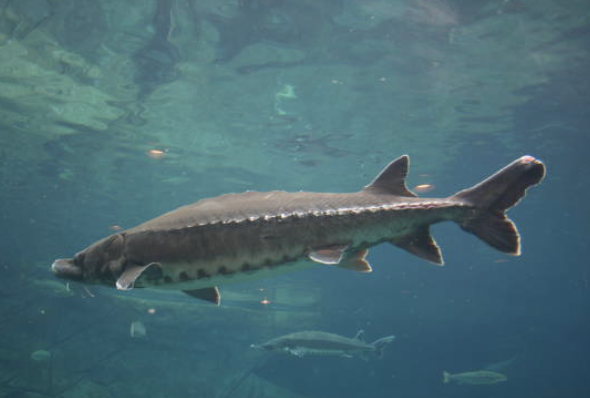
Lifespan: Can live up to 60 years, more commonly seen in northern waters whereas in the southeast Atlantic sturgeon will like closer to 25-30 years due to them reaching sexual maturity earlier in warmer waters.
Size:
- Up to 14 ft., but more commonly 5-6 ft.
- Up to 800 lb., but more commonly 160 lb.
Diet: Sturgeon are bottom feeders eating benthic creatures such as mollusks, crustations, worms, small bottom dwelling fish, and other invertebrates such as sand lice.
Adaptations:
- Sturgeon have a long snout that enables them to brush up sand and mud to find food- their mouth serving as a vacuum.
- Sturgeon have modified scales that are bony plates, called scutes. These act as armor and protect sturgeon from any natural predators.
- Their mouths are found underneath them, similar to rays. They use their protrusible mouth as a vacuum to look for and eat food. Sturgeon do not have teeth but rely on their strong stomach muscles to breakdown the food they swallow whole.
- Near their mouth, sturgeon have barbels, which are their built-in sensors for food. These barbels drag along the ocean floor to help find prey.
- Atlantic Sturgeon have a “shark-like” tail that enables them to swiftly swim through the water and change direction quickly
Range: Can span in rivers and coastal waters from Canada to Florida.
History: Atlantic sturgeon have been on earth for around 120 million years. They are a prehistoric animal that can be found in fossils from the Cretaceous period.
- 2000BCE: Indigenous populations along the New England coast hunted and fished for sturgeon using a variety of methods, including spears, nets, and weirs. Contemporaneous accounts from European settler colonists describe a fishing practice where hunters would go out at night in their canoes and shine a torch into the water. When the sturgeon came up to the surface to investigate, they would then use their clubs or spears to capture the fish?
- 1600s: Sturgeon populations are so plentiful that a contemporary account described being practically able to cross the James River by stepping on the backs of sturgeon. European settler colonists were initially skeptical of using sturgeon as a food source, despite it being a dietary staple for local indigenous people. However, out of necessity, European settler colonists began using them as a food source, and sturgeon are credited as saving the Jamestown colony from famine4. ?
- Late 1800s: “Black Gold Rush” - Large numbers of people flocked to the Eastern coast of the US to harvest sturgeon for caviar. Sturgeon populations fell dramatically – in 1887, 7 million pounds of sturgeon were reported as caught, whereas that number dropped to 20,000 pounds in 1905 (note: historical records of sturgeon landings did not generally differentiate between Atlantic and Short nosed sturgeon).
- 1967: Short nose sturgeon are listed as federally endangered (this predates the endangered species act)
- 1980: Atlantic Sturgeon are believed to be locally extinct from the Connecticut river7?
- 1998: The Atlantic States Marine Fisheries Commission moratorium for Atlantic sturgeon in all U.S. waters began ?
- 2012: 4 distinct population segments (DPS) of Atlantic Sturgeon are listed as endangered (New York Bight DPS, Chesapeake Bay DPS, Carolina DPS, South Atlantic DPS) and one is listed as threatened (Gulf of Main DPS). ?
- 2017: Each of the population segments of Atlantic Sturgeon receive critical habitat designation in key areas of spawning, rearing, and other important water features. This means that “Federal agencies that undertake, fund, or permit activities that may affect these designated critical habitat areas are required to consult with NOAA Fisheries to ensure that their actions do not adversely modify or destroy designated critical habitat”
Conservation status: All 5 US populations of Atlantic Sturgeon (Carolina, Chesapeake, NY Bight, South Atlantic, Gulf of Maine) are protected under the Endangered Species Act. Populations found in Canada are not protected under US policy.
Predators: Due to their adaptation of bony plates, scutes, they have few predators. Human impact is their greatest threat due to overfishing and habitat loss.
Our Sturgeon:
Sturgeon Touch Tank Exhibit Info:
- Opened July 2023
- Habitat is size is 7,000 gallons of water.
- The figure 8 shape of the pool gives the sturgeon an easy way to constantly swim similar to the ray pool. One side of the touch tank is deeper than the other allowing the sturgeon to have refugees if they do not want to interact with guests. This allows the animals to have choice and control over their interactions with guests. Per AZA (Association of Zoo’s and Aquariums) regulations all animals must have a refugee available to them.
- This is a good talking point for if the sturgeon are not going up to the sides
- This is also a good talking point if guests feel uncomfortable with the touch tanks. Some may think it is “sad” to see these animals in this position so it is beneficial to explain this side of animal care that they may not know. You can task the guest, especially if they are younger, to look for animal’s refugee spots in other exhibits. It is a tricky and fun task since animal refugees are meant to blend into their habitats.
- Our sturgeon were acquired in 2014 at the conclusion of a research project by Maryland Department of Natural Resources. We estimate they were 1-2 years of age when we received them.
Atlantic Salmon (Salmo salar)
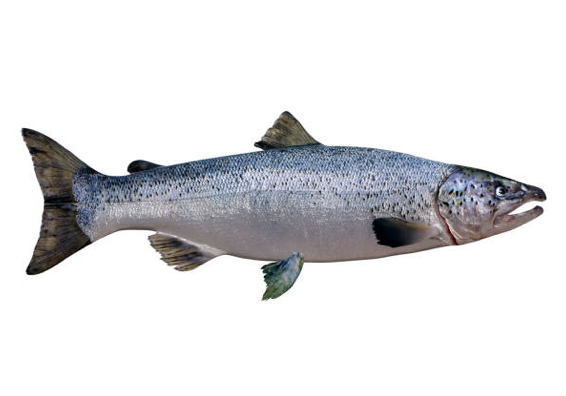

Size: Average length: 30 inches. Average weight: 8-12 pounds
Shape & Color: Fusiform body. Silver-blue with black spots above the lateral line. During reproduction, males have a slight green or red color.
Reproduction: Atlantic salmon are anadromous. In the spring and fall, salmon migrate from the sea to freshwater rivers to find nesting sites. Shallow, protected and rocky bottoms are ideal for egg laying. Atlantic salmon may travel up to 100 miles up the Connecticut River, to return to their birthplace to spawn a next generation. After spawning, migrating salmon return to the sea.
Brown Trout (Salmo trutta) 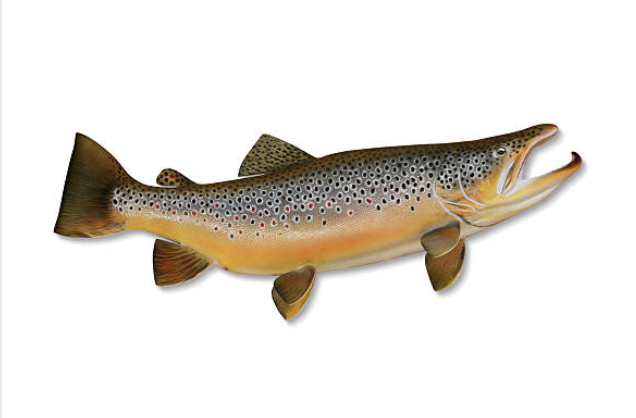
Size: Average weight is about 20 pounds, but in smaller rivers will commonly be just over 2 pounds
Shape & Color: Fusiform body. Color ranges from bassy brown with medium-sized spots to mostly silver with fewer spots.
Reproduction: Brown trout are closely related to Atlantic salmon, and they exhibit similar spawning behavior. Females can produce 900 eggs per pound of body weight.
Lifespan: Brown trout can live up to 20 years, but a high proportion of both male and female die after spawning.
Bluegill (Lepomis macrochirus) 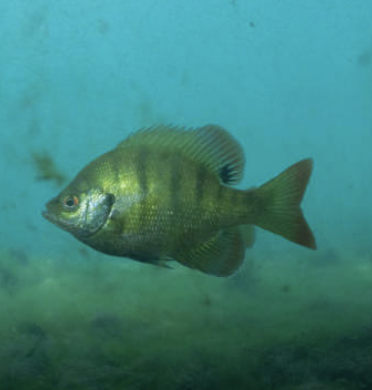

Size: Bluegills can typically grow up to 12 inches long and weigh around 4 1/2 pounds
Shape & Color: Deep, flattened body. Terminal mouth. Ctenoid scales (having many teeth-like projections). Lateral line arches upward anteriorly (towards the front)
Lifespan: Average 5-8 years